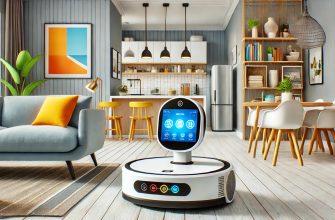Robots in Elderly Care and Nursing Homes
As the global population ages, the need for high-quality elderly care increases. One innovative solution to this challenge is using robots in nursing homes and elderly care facilities.
Robots offer a range of benefits, from enhancing daily care to improving social interaction, and can help address staffing shortages in the industry. In this article, we will explore how robots are transforming the world of elderly care.
Types of Robots Used in Elderly Care
Assistive Robots
Assistive robots are designed to help seniors with daily tasks like eating, dressing, and bathing. These robots often have specialized features like gripping arms or voice recognition technology to perform these tasks efficiently and safely.
Companion Robots
Companion robots focus on providing emotional support and social interaction for seniors. They can engage in conversations, recognize emotions, and even mimic human-like expressions. These robots can help combat loneliness and improve seniors’ overall well-being.
Benefits of Robots in Elderly Care
Reduced Workload for Caregivers
By taking on routine tasks like lifting or medication management, robots can help ease the workload of human caregivers. This allows caregivers to focus on more personalized, high-quality care for residents and reduces the risk of burnout.
Enhanced Social Interaction
Companion robots offer opportunities for social engagement, helping seniors stay mentally stimulated and connected. These robots can also provide comfort and companionship for residents with limited social interactions due to mobility or health issues.
Challenges and Considerations
Cost and Implementation
One challenge in integrating robots into elderly care facilities is the cost of purchasing and maintaining these advanced technologies. However, as technology continues to evolve, the price of robots is expected to decrease, making them more accessible for widespread adoption.
Ethical and Privacy Concerns
As with any technology, ethical and privacy concerns must be addressed when implementing robots in elderly care. Data protection and proper handling of personal information are vital to ensure residents’ privacy and security.
The Future of Robotics in Elderly Care
Advancements in AI and Robotics
As AI and robotics technology continue to improve, robots will become more capable of providing comprehensive care for seniors. The potential for greater personalization and adaptability in care will make robots even more valuable in the nursing home setting.
Potential Expansion to Home Care
As robots become more affordable and advanced, they may be increasingly used in home care settings, helping seniors age in place and receive personalized care in their homes.
Integration into Mainstream Elderly Care
Robots becoming more advanced and affordable, will likely become a standard part of elderly care in nursing homes and private residences. This integration will help address the growing demand for care services while improving seniors’ overall quality of life, making robots an essential part of the future of elderly care.
A New Era of Companion Robots
Emotional Support for Seniors
As the elderly population grows, providing emotional support to seniors is becoming increasingly important. Companion robots, designed to interact with the elderly and provide social stimulation, are helping to fill this need.
These robots can engage in conversation, recognize emotions, and respond accordingly to offer comfort and companionship to the elderly.
Reducing Loneliness and Isolation
Loneliness and social isolation are significant issues for seniors, especially those in nursing homes. Companion robots can offer a continuous presence, helping to alleviate loneliness and isolation.
With features like voice recognition and natural language processing, these robots can engage seniors in conversation and provide a sense of connection.
Robots Assisting with Dementia Care
Cognitive Stimulation and Interaction
Dementia patients require specialized care, and robots can provide cognitive stimulation and interaction. Robots designed for dementia care can engage patients in activities that promote cognitive function, such as memory games and puzzles.
These robots can also recognize behavioral patterns and adjust their interactions accordingly to provide a personalized experience for each patient.
Safe Wandering and Monitoring
Wandering can be a significant concern for dementia patients, risking their safety. Robots equipped with sensors and GPS technology can safely monitor and guide dementia patients during their wandering episodes.
By ensuring patients don’t wander into dangerous areas or situations, these robots provide additional security and peace of mind for caregivers and family members.
Ethical Considerations in Robotic Elderly Care
Balancing Human and Robotic Interaction
While robots can offer significant benefits to elderly care, it’s crucial to strike a balance between human and robotic interaction. Ensuring seniors maintain meaningful relationships with human caregivers and family members is essential for their emotional well-being. It’s important to view robots as a complement to human care rather than a replacement.
Privacy and Data Security
As robots in elderly care collect and process sensitive patient information, privacy, and data security are significant concerns. Developers and care providers must prioritize implementing robust security measures to protect the personal data of seniors and ensure their privacy is maintained.
FAQ
Are robots replacing human caregivers in elderly care facilities?
How do companion robots help improve seniors’ well-being?
Are robots in elderly care expensive?
How can robots help address staffing shortages in elderly care?
- https://www.nature.com/articles/d41586-022-00072-z
- https://www.technologyreview.com/2023/01/09/1065135/japan-automating-eldercare-robots/
- https://time.com/longform/senior-care-robot/
- https://ec.europa.eu/research-and-innovation/en/horizon-magazine/elderly-care-bring-robots
- https://happyseniors.care/en/robotic-for-eldercare-and-companionship/








